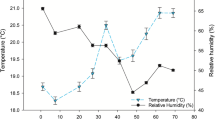Abstract
The allelopathic potential of Ageratum conyzoides was investigated under different environmental stress conditions, including nutrient deficiency, physical damage, 2,4-D treatment, competition with Bidens pilosa, infection with Erysiphe cichoracearum, and feeding by Aphiids gossypii. The inhibitory effects of A. conyzoides volatiles on peanut (Arachis hypogaea), redroot amaranth (Amaranthus retroflexus), cucumber (Cucumis sativus), and ryegrass (Lolium multiforum) increased when plants were grown under nutrient-deficient conditions or in competition with B. pilosa; however, there was no difference with physical damage or 2,4-D treatment. Phytoinhibitory effects decreased under fungal infection and aphid feeding. Volatiles from A. conyzoides plants infected with E. cichoracearum or exposed to A. gossypii feeding inhibited or killed fungi and insects. Precocenes and their derivatives, monoterpenes, and sesquiterpenes were the major volatile components of A. conyzoides.
Similar content being viewed by others
REFERENCES
Agrawal, A. A. 1998. Induced response to herbivory and increased plant performance. Science 279:1201–1202.
Baziramaberga, r., simard, r. r., and Lexonx, G. D. 1994. Effects of benzoic and cinnamic acids on growth, mineral compositions and chlorophyll content of soybean. J. Chem. Ecol. 20:2821– 2831.
Berenbaum, M. R. 1985. Brementown revisited: Interactions among allelochemicals in plants. Recent Adv. Phytochem. 19:139–169.
Dicke, M. 1994. Local and systemic production of volatile herbovore-induced terpenoids: Their role in plant-herbivore mutualism. J. Plant Physiol. 143:465–472.
Einhellig, F. A. 1987. Interactions among allelochemicals and other stress factors of the plant environment. ACS Symp. Ser. 330:343–357.
Einhellig, F. A. 1996. Interactions involving allelopathy in cropping system. Agron. J. 88:886–893.
Hammerschmidt, R., Nuckles, E. M., and Kuc, J. 1982. Association of enhanced peroxidase activity with induced systemic resistance of cucumber to Collectrchum lagenarium. Physiol. Plant Pathol. 20:73–82.
josep p. and joan l.1997. Effects of carbondioxide water supply and seasonally on terpene content and emission byrosmarinusofficinalis.j.chem.ecol. 23 979–993.
Kong, C., Xu, T., and Hu, F. 1998a. Allelopathy of Ageratum conyzoides II: Releasing mode and activity of main allelochemicals. Chin. J. Appl. Ecol. 9:6257–260 (in Chinese).
Kong, C., Xu, T., and Hu, F. 1998b. Study on interactions among allelochemicals of A. conyzoides. Acta Phytoecol. Sin. 22:403–408 (in Chinese).
Kong, C., Hu, F., Xu, T., and Liu, Y. 1999. Allelopathic potential and chemical constituents of volatile oil from A. conyzoides. J. Chem. Ecol. 25:2347–2356.
Kong, C., Xu, T., Hu, F., and Huang, S. 2000. Allelopathy under environmental stress and its induced mechanism. Acta Ecol. Sin. 20:849–854 (in Chinese).
Loughrin, J. H., Nanakian, A., Heath, R. R., and Tumlinson, J. H. 1995. Volatiles emitted by different cotton varieties damaged by feeding beet armyworm larvae. J. Chem. Ecol. 21:1217–1227.
Pare, P. W. and Tumlinson, J. H. 1997. Induced synthesis of plant volatiles. Nature 385:30–31.
Robertson, J. L. and Preisler, H. K. 1992. Pesticide bioassays with arthropods. CRC, Boca Raton, Florida.
Romeo, J. T. 1998. Functional multiplicity among nonprotein amino acids in mimosoid legumes: A case against redundancy. Ecoscience 5:287–294.
Rose, U. S. R., Manukian, A., Heath, R. R., and Tumlinson, J. H. 1995. Volatile semiochemicals released from undamaged cotton leaves. Plant Physiol. 111:487–495.
Saiki, H. and Yoneda, K. 1981. Possible dual roles of an allelopathic compound, cis-dehydromatricaria ester. J. Chem. Ecol. 8:185–193.
Seigler, D. S. and Price, P. W. 1976. Secondary compounds in plants: Primary functions. Am. Nat. 110:101–104.
Tang, C. S. 1995. Plant stress and allelopathy. ACS Symp. Ser. 582:142–157.
Williamson, G.B. and Richardson, D. 1988. Biossays for allelopathy: Measuring treatment response with independent controls. J. Chem. Ecol. 14:181–188.
Author information
Authors and Affiliations
Corresponding author
Rights and permissions
About this article
Cite this article
Kong, C., Hu, F. & Xu, X. Allelopathic Potential and Chemical Constituents of Volatiles from Ageratum conyzoides Under Stress. J Chem Ecol 28, 1173–1182 (2002). https://doi.org/10.1023/A:1016229616845
Issue Date:
DOI: https://doi.org/10.1023/A:1016229616845




